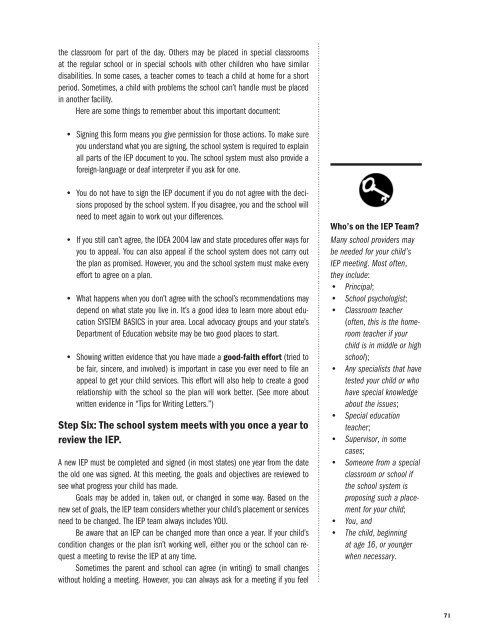Family Road Map Guide
Create successful ePaper yourself
Turn your PDF publications into a flip-book with our unique Google optimized e-Paper software.
the classroom for part of the day. Others may be placed in special classrooms<br />
at the regular school or in special schools with other children who have similar<br />
disabilities. In some cases, a teacher comes to teach a child at home for a short<br />
period. Sometimes, a child with problems the school can’t handle must be placed<br />
in another facility.<br />
Here are some things to remember about this important document:<br />
• Signing this form means you give permission for those actions. To make sure<br />
you understand what you are signing, the school system is required to explain<br />
all parts of the IEP document to you. The school system must also provide a<br />
foreign-language or deaf interpreter if you ask for one.<br />
• You do not have to sign the IEP document if you do not agree with the decisions<br />
proposed by the school system. If you disagree, you and the school will<br />
need to meet again to work out your differences.<br />
• If you still can’t agree, the IDEA 2004 law and state procedures offer ways for<br />
you to appeal. You can also appeal if the school system does not carry out<br />
the plan as promised. However, you and the school system must make every<br />
effort to agree on a plan.<br />
• What happens when you don’t agree with the school’s recommendations may<br />
depend on what state you live in. It’s a good idea to learn more about education<br />
SYSTEM BASICS in your area. Local advocacy groups and your state’s<br />
Department of Education website may be two good places to start.<br />
• Showing written evidence that you have made a good-faith effort (tried to<br />
be fair, sincere, and involved) is important in case you ever need to file an<br />
appeal to get your child services. This effort will also help to create a good<br />
relationship with the school so the plan will work better. (See more about<br />
written evidence in “Tips for Writing Letters.”)<br />
Step Six: The school system meets with you once a year to<br />
review the IEP.<br />
A new IEP must be completed and signed (in most states) one year from the date<br />
the old one was signed. At this meeting, the goals and objectives are reviewed to<br />
see what progress your child has made.<br />
Goals may be added in, taken out, or changed in some way. Based on the<br />
new set of goals, the IEP team considers whether your child’s placement or services<br />
need to be changed. The IEP team always includes YOU.<br />
Be aware that an IEP can be changed more than once a year. If your child’s<br />
condition changes or the plan isn’t working well, either you or the school can request<br />
a meeting to revise the IEP at any time.<br />
Sometimes the parent and school can agree (in writing) to small changes<br />
without holding a meeting. However, you can always ask for a meeting if you feel<br />
Who’s on the IEP Team?<br />
Many school providers may<br />
be needed for your child’s<br />
IEP meeting. Most often,<br />
they include:<br />
• Principal;<br />
• School psychologist;<br />
• Classroom teacher<br />
(often, this is the homeroom<br />
teacher if your<br />
child is in middle or high<br />
school);<br />
• Any specialists that have<br />
tested your child or who<br />
have special knowledge<br />
about the issues;<br />
• Special education<br />
teacher;<br />
• Supervisor, in some<br />
cases;<br />
• Someone from a special<br />
classroom or school if<br />
the school system is<br />
proposing such a placement<br />
for your child;<br />
• You, and<br />
• The child, beginning<br />
at age 16, or younger<br />
when necessary.<br />
71














